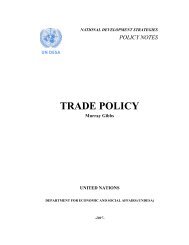16th Meeting of Senior Fellowships Officers of the ... - Development
16th Meeting of Senior Fellowships Officers of the ... - Development
16th Meeting of Senior Fellowships Officers of the ... - Development
Create successful ePaper yourself
Turn your PDF publications into a flip-book with our unique Google optimized e-Paper software.
Operational Issues 23<br />
F. Presentation on South-South Cooperation: <strong>the</strong> Case <strong>of</strong><br />
Fellowship Placements in Africa, by Dr. Akpa R. Gbary,<br />
Regional Adviser, Human Resource for Health, WHO/AFRO<br />
79. Dr. Gbary took <strong>the</strong> floor to present <strong>the</strong> successes and challenges faced by WHO/AFRO<br />
in <strong>the</strong> framework <strong>of</strong> South-South cooperation when managing fellowships in Africa,<br />
in particular, <strong>the</strong> issue <strong>of</strong> placement. The fellowships programme was one <strong>of</strong> <strong>the</strong> most<br />
popular in <strong>the</strong> UN and especially in WHO. In Africa, after independence, <strong>the</strong> public<br />
health specialties were not very popular. WHO had to scale up a fast-track programme<br />
in order to reach a critical mass <strong>of</strong> health practitioners in <strong>the</strong> area <strong>of</strong> public health.<br />
80. One <strong>of</strong> <strong>the</strong> success stories was <strong>the</strong> increase in <strong>the</strong> number <strong>of</strong> training activities. Of <strong>the</strong><br />
forty six African countries and seven African countries belonging to <strong>the</strong> Eastern and<br />
Mediterranean Region (EMR), thirty five experienced a shortage <strong>of</strong> public health. <strong>Fellowships</strong><br />
had played a vital role in filling in those gaps. Until 1978 only a low number<br />
<strong>of</strong> fellows, no more than 65%, had been placed in Africa. In 1979, <strong>the</strong> Ministers <strong>of</strong> 46<br />
African countries came up with a resolution 12 which requested to drastically increase<br />
<strong>the</strong> rate <strong>of</strong> placement <strong>of</strong> fellows in Africa in order to recognize <strong>the</strong> potential <strong>of</strong>fered by<br />
African countries and to curb <strong>the</strong> brain drain <strong>of</strong> fellows who could be placed in North<br />
America and Europe. Statistics <strong>of</strong> <strong>the</strong> last 5 years indicated that <strong>the</strong> rate <strong>of</strong> placement<br />
in Africa, including Morocco, Tunisia and Algeria, rose from 65% in 1979, to 92% in<br />
2001, to 93% in 2003 and up to almost 95% in 2006.<br />
81. Each country which hosted fellows in Africa had a regional WHO training center. Such<br />
centers were situated in Lome, Togo, where WHO trained specialized nurses and midwives;<br />
in <strong>the</strong> small town <strong>of</strong> Ouidha in Benin where post-graduate studies were <strong>of</strong>fered in<br />
epidemiology and public health. In addition, <strong>the</strong>re were centers <strong>of</strong> excellence in South<br />
Africa, Kenya and Zimbabwe. WHO/AFRO awarded training and fellowships within<br />
Africa to undertake undergraduate studies in medicine, midwifery, nursery, laboratory<br />
technicians and o<strong>the</strong>r health workers. It also provided post-graduate studies in clinical<br />
medicine, various areas <strong>of</strong> public health and health management. Never<strong>the</strong>less, WHO<br />
still continued to send fellows to countries in Europe and Nor<strong>the</strong>rn America, to specialize<br />
particularly in dentistry and some very high level clinical specialties such as cardiology,<br />
surgery, neurology, forensic medicine and in exceptional cases to pursue PhD studies.<br />
82. In terms <strong>of</strong> costs, fellowships across Africa recorded substantial savings. The average<br />
cost per fellow in this continent was about 18,000 US dollars as compared to 45,000<br />
US dollars in Europe and 42,000 US dollars in <strong>the</strong> United States <strong>of</strong> America. Surveys<br />
<strong>of</strong> costs by region fur<strong>the</strong>r showed that fellows placed in Eastern and Mediterranean<br />
countries, such as Morocco and Tunisia, as well as in <strong>the</strong> South East Asian Region<br />
(SEAR) incurred comparable expenditures to <strong>the</strong> fellows placed in <strong>the</strong> African Region<br />
whereas <strong>the</strong> Western Pacific Region had slightly higher rates but still remained in <strong>the</strong><br />
range <strong>of</strong> <strong>the</strong> African, EMR and SEAR rates.<br />
12<br />
Regional Committee 39, resolution 39/5

















